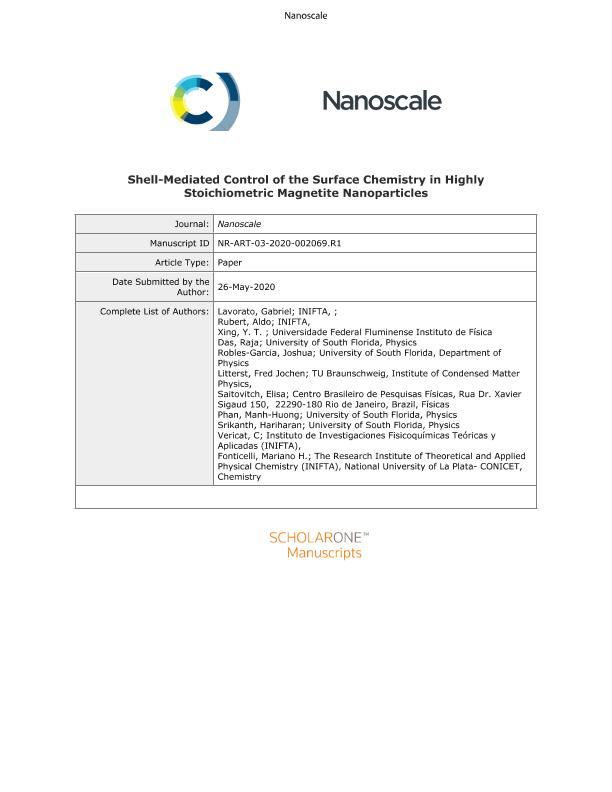Mostrar el registro sencillo del ítem
dc.contributor.author
Lavorato, Gabriel Carlos

dc.contributor.author
Rubert, Aldo Alberto

dc.contributor.author
Xing, Yutao
dc.contributor.author
Das, Raja
dc.contributor.author
Robles, Joshua
dc.contributor.author
Jochen Litterst, F.
dc.contributor.author
Baggio Saitovitch, Elisa
dc.contributor.author
Phan, Manh Huong
dc.contributor.author
Srikanth, Hariharan
dc.contributor.author
Vericat, Carolina

dc.contributor.author
Fonticelli, Mariano Hernan

dc.date.available
2021-09-28T17:30:27Z
dc.date.issued
2020-07
dc.identifier.citation
Lavorato, Gabriel Carlos; Rubert, Aldo Alberto; Xing, Yutao; Das, Raja; Robles, Joshua; et al.; Shell-mediated control of surface chemistry of highly stoichiometric magnetite nanoparticles; Royal Society of Chemistry; Nanoscale; 12; 25; 7-2020; 13626-13636
dc.identifier.issn
2040-3364
dc.identifier.uri
http://hdl.handle.net/11336/141738
dc.description.abstract
Magnetite (Fe3O4) nanoparticles are one of the most studied nanomaterials for different nanotechnological and biomedical applications. However, Fe3O4 nanomaterials gradually oxidize to maghemite (γ-Fe2O3) under conventional environmental conditions leading to changes in their functional properties that determine their performance in many applications. Here we propose a novel strategy to control the surface chemistry of monodisperse 12 nm magnetite nanoparticles by means of a 3 nm-thick Zn-ferrite epitaxial coating in core/shell nanostructures. We have carried out a combined Mössbauer spectroscopy, dc magnetometry, X-ray photoelectron spectroscopy and spatially resolved electron energy loss spectroscopy study on iron oxide and Fe3O4/Zn0.6Fe2.4O4 core/shell nanoparticles aged under ambient conditions for 6 months. Our results reveal that while the aged iron oxide nanoparticles consist of a mixture of γ-Fe2O3 and Fe3O4, the Zn-ferrite-coating preserves a highly stoichiometric Fe3O4 core. Therefore, the aged core/shell nanoparticles present a sharp Verwey transition, an increased saturation magnetization and the possibility of tuning the effective anisotropy through exchange-coupling at the core/shell interface. The inhibition of the oxidation of the Fe3O4 cores can be accounted for in terms of the chemical nature of the shell layer and an epitaxial crystal symmetry matching between the core and the shell.
dc.format
application/pdf
dc.language.iso
eng
dc.publisher
Royal Society of Chemistry

dc.rights
info:eu-repo/semantics/openAccess
dc.rights.uri
https://creativecommons.org/licenses/by-nc-sa/2.5/ar/
dc.subject
NANOPARTICULAS CORE-SHELL
dc.subject
MAGNETITA
dc.subject
FERRITA DE Zn
dc.subject
OXIDACIÓN DE CORE
dc.subject.classification
Física de los Materiales Condensados

dc.subject.classification
Ciencias Físicas

dc.subject.classification
CIENCIAS NATURALES Y EXACTAS

dc.subject.classification
Química Coloidal

dc.subject.classification
Ciencias Químicas

dc.subject.classification
CIENCIAS NATURALES Y EXACTAS

dc.title
Shell-mediated control of surface chemistry of highly stoichiometric magnetite nanoparticles
dc.type
info:eu-repo/semantics/article
dc.type
info:ar-repo/semantics/artículo
dc.type
info:eu-repo/semantics/publishedVersion
dc.date.updated
2021-09-06T17:26:46Z
dc.identifier.eissn
2040-3372
dc.journal.volume
12
dc.journal.number
25
dc.journal.pagination
13626-13636
dc.journal.pais
Reino Unido

dc.journal.ciudad
Londres
dc.description.fil
Fil: Lavorato, Gabriel Carlos. Consejo Nacional de Investigaciones Científicas y Técnicas. Centro Científico Tecnológico Conicet - La Plata. Instituto de Investigaciones Fisicoquímicas Teóricas y Aplicadas. Universidad Nacional de La Plata. Facultad de Ciencias Exactas. Instituto de Investigaciones Fisicoquímicas Teóricas y Aplicadas; Argentina
dc.description.fil
Fil: Rubert, Aldo Alberto. Consejo Nacional de Investigaciones Científicas y Técnicas. Centro Científico Tecnológico Conicet - La Plata. Instituto de Investigaciones Fisicoquímicas Teóricas y Aplicadas. Universidad Nacional de La Plata. Facultad de Ciencias Exactas. Instituto de Investigaciones Fisicoquímicas Teóricas y Aplicadas; Argentina
dc.description.fil
Fil: Xing, Yutao. Universidade Federal Fluminense; Brasil
dc.description.fil
Fil: Das, Raja. Phenikaa University; Vietnam. Phenikaa Research and Technology Institute; Vietnam
dc.description.fil
Fil: Robles, Joshua. University of South Florida. Department of Physics; Estados Unidos
dc.description.fil
Fil: Jochen Litterst, F.. Centro Brasileiro de Pesquisas Físicas; Brasil. Technische Universitat Carolo Wilhelmina Zu Braunschweig.; Alemania
dc.description.fil
Fil: Baggio Saitovitch, Elisa. Centro Brasileiro de Pesquisas Físicas; Brasil
dc.description.fil
Fil: Phan, Manh Huong. University of South Florida. Department of Physics; Estados Unidos
dc.description.fil
Fil: Srikanth, Hariharan. University of South Florida. Department of Physics; Estados Unidos
dc.description.fil
Fil: Vericat, Carolina. Consejo Nacional de Investigaciones Científicas y Técnicas. Centro Científico Tecnológico Conicet - La Plata. Instituto de Investigaciones Fisicoquímicas Teóricas y Aplicadas. Universidad Nacional de La Plata. Facultad de Ciencias Exactas. Instituto de Investigaciones Fisicoquímicas Teóricas y Aplicadas; Argentina
dc.description.fil
Fil: Fonticelli, Mariano Hernan. Consejo Nacional de Investigaciones Científicas y Técnicas. Centro Científico Tecnológico Conicet - La Plata. Instituto de Investigaciones Fisicoquímicas Teóricas y Aplicadas. Universidad Nacional de La Plata. Facultad de Ciencias Exactas. Instituto de Investigaciones Fisicoquímicas Teóricas y Aplicadas; Argentina
dc.journal.title
Nanoscale
dc.relation.alternativeid
info:eu-repo/semantics/altIdentifier/doi/http://dx.doi.org/10.1039/d0nr02069a
dc.relation.alternativeid
info:eu-repo/semantics/altIdentifier/url/https://pubs.rsc.org/en/content/articlelanding/2020/NR/D0NR02069A
Archivos asociados
